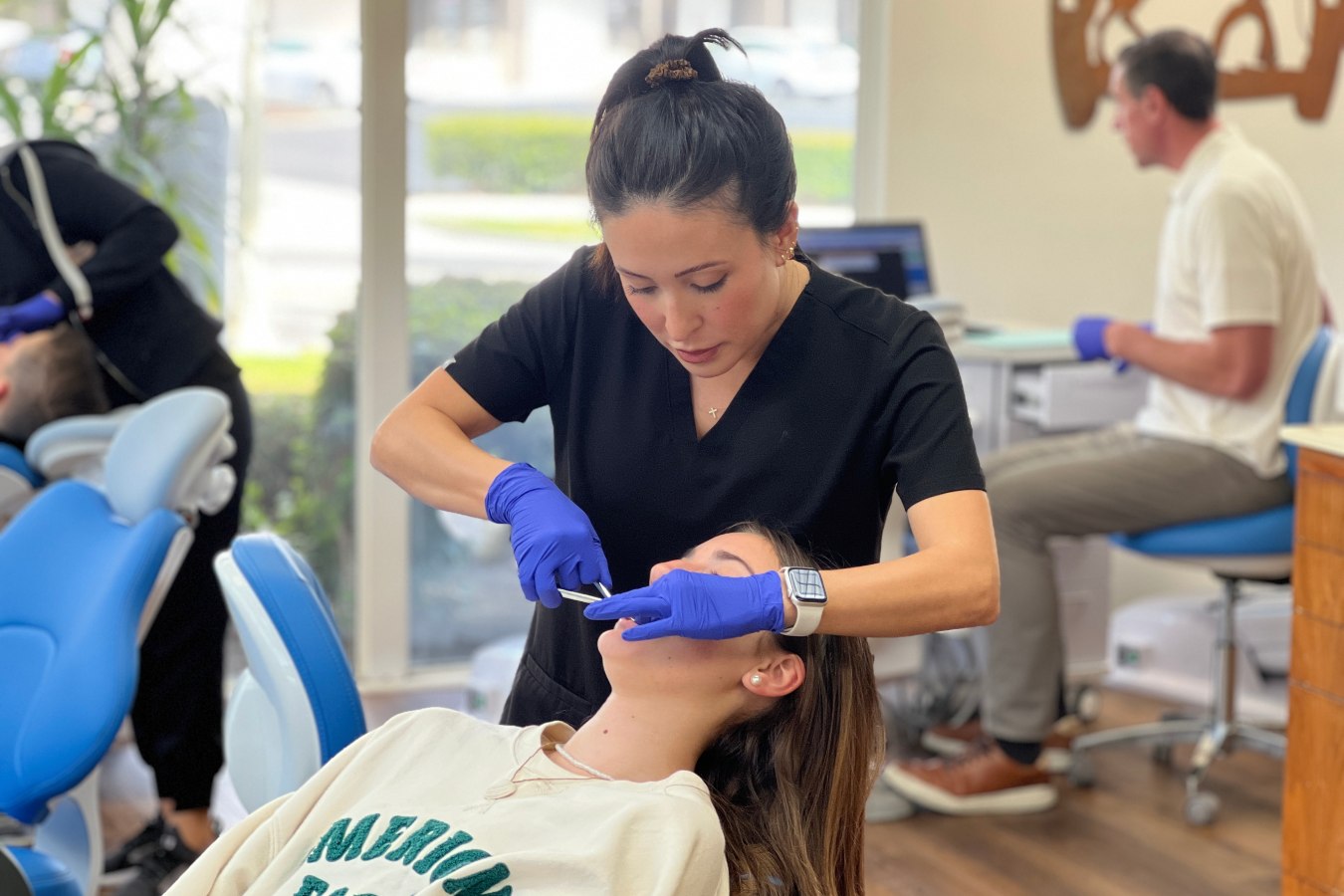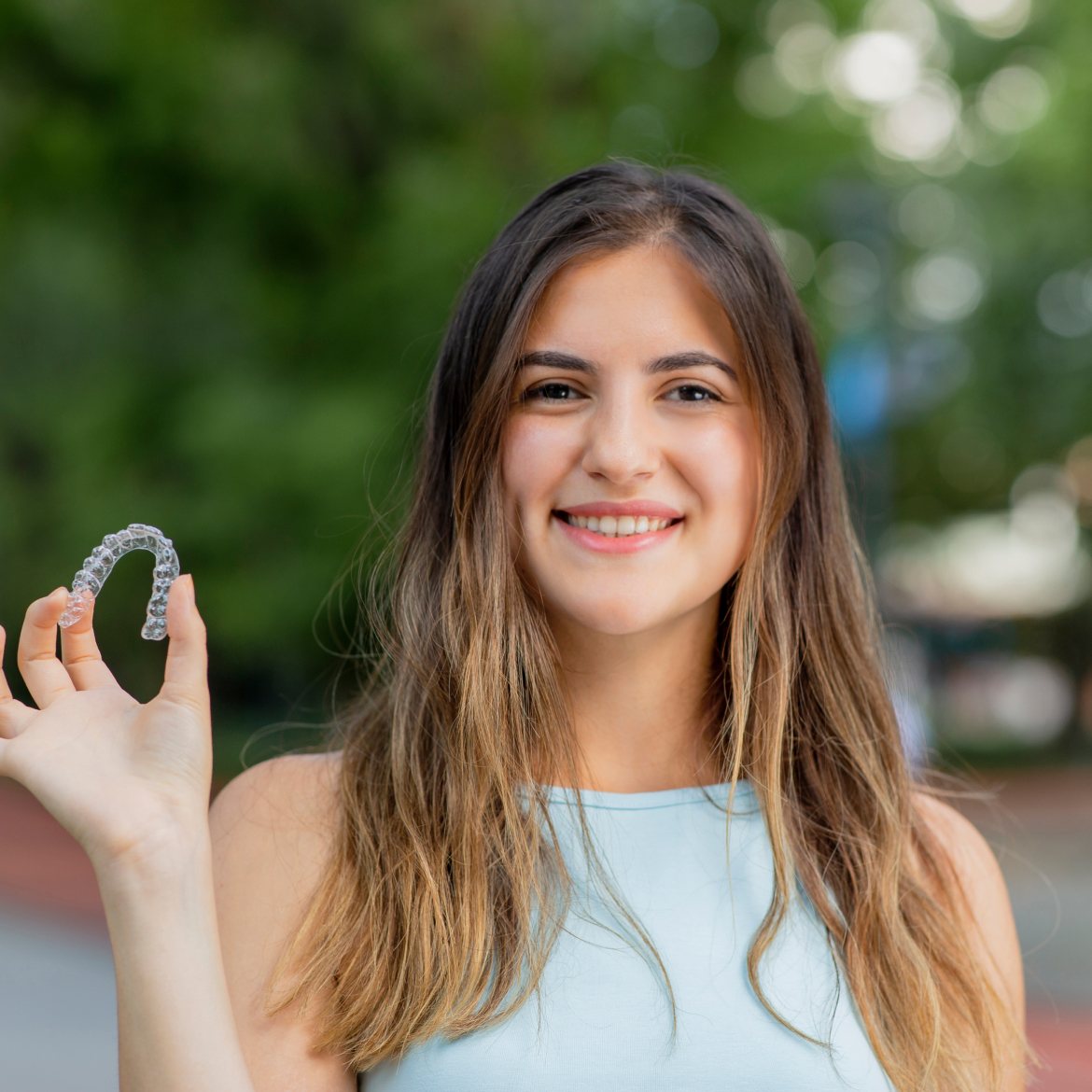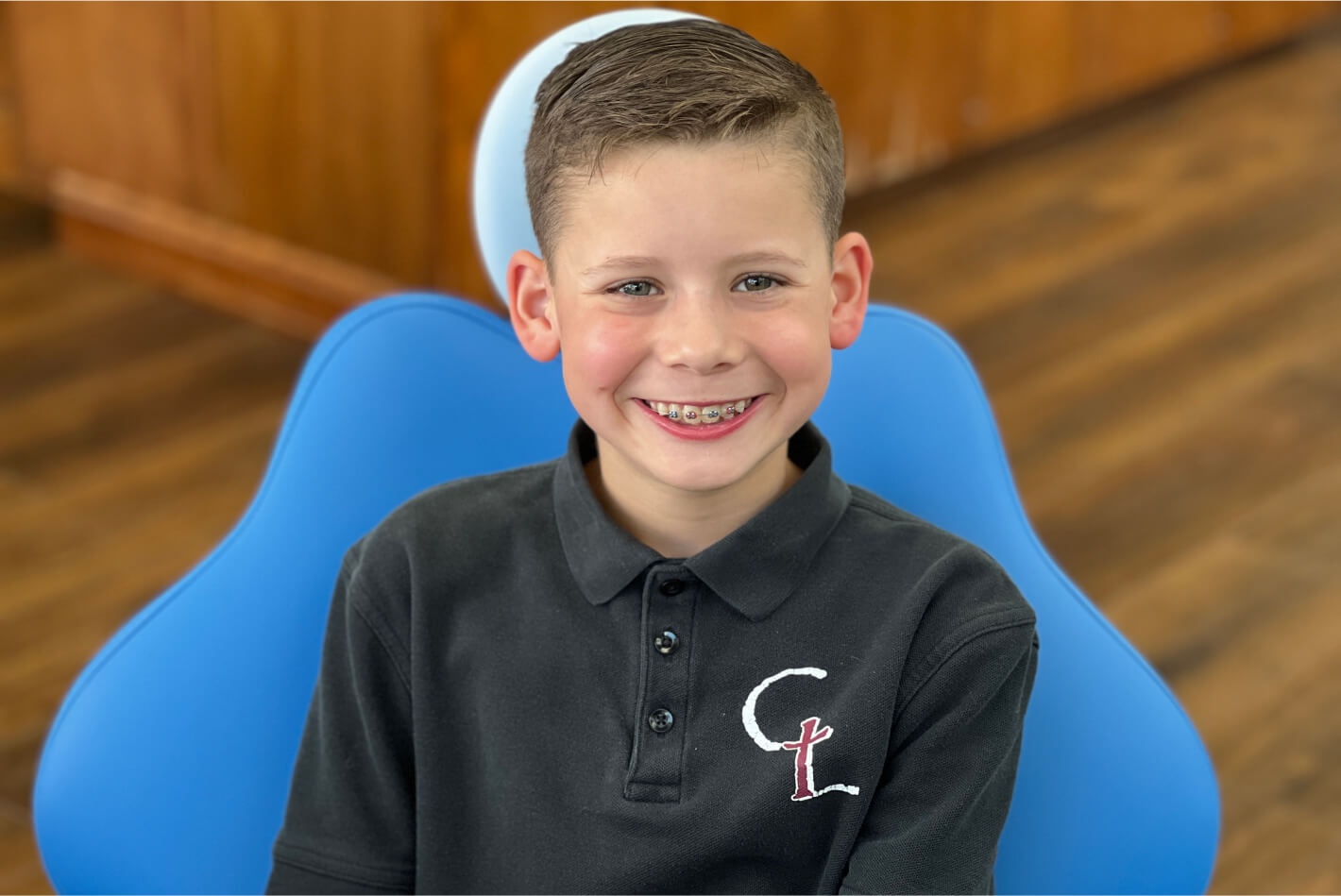Whether you’re considering braces for yourself or a loved one, this guide is designed to provide you with all the information you need to make informed decisions about orthodontic care. At Potter Orthodontics, we understand that a straight, healthy smile can significantly enhance your overall well-being and confidence. Our expert team is dedicated to delivering top-notch orthodontic treatment tailored to meet your individual needs. In this guide, we’ll cover everything from the different types of braces available to the benefits of orthodontic treatment and what you can expect during your braces journey. Let us help you navigate the path to a beautiful, aligned smile with ease and confidence.

Common Issues
Class II
Class II dental problems represent abnormal bite relationships in which the upper jaw and teeth project ahead of the lower jaw called ‘overjet”. Class II patients usually exhibit a convex facial profile with a deficient chin prominence. Typically, a Class II problem is inherited. Persistent thumbsucking can also aggravate these problems. Correcting of this disorder generally requires influencing facial growth to bring the upper and lower jaws and teeth to their proper position.
Class III
Class III dental problems are primarily genetic in origin. In this instance, the lower jaw and teeth are displaced to the front of the upper jaw structures. The facial appearance may give the impression that the lower jaw is excessively large, but in many cases the lack of upper jaw is at fault.
Crossbite
Posterior crossbites usually result from a constricted upper jaw or unusually wide lower jaw. A narrow upper jaw will often force a patient to move their lower jaw forward or to the side when closing into a stable bite. When closed into this accomodated position. the lower teeth are located outside the upper teeth. This posturing may result in an incorrect functional position of the lower jaw with accompanying facial asymmetry.
Crowding
Crowding of the teeth is the most common dental problem associated with the need for orthodontic care. Although many factors contribute to the dental crowding. this problem usually stems from a discrepancy between space available in each jaw and the size of the teeth. Aside from aesthetic considerations, poor alignment of teeth may be associated with periodontal problems and an increased risk of dental decay due to difficulty in maintaining proper oral hygiene.
Deep Bite
Excessive vertical overlapping of incisor teeth called deep bite or “overbite” is generally found in association with a discrepancy between the length of the upper and lower jaws. It usually results in excessive eruption of either the upper or lower incisors or both. Associated problems include: excessive display of gum tissue, lip protrusion or entrapment, biting the roof of the mouth and incisor wear.
Open Bite
A lack of vertical overlap of the incisor teeth can usually be traced to jaw disharmony, persistent habits (i.e. thumb sucking and posturing of the tongue between the front teeth) or excessive vertical growth of one or both jaws. Early assessment and intervention is critical to the overall success of treating these disorders.
Spacing
Spaces between teeth are another common problem associated with the need for orthodontic care. Like crowding, spacing may be related to a tooth-to-jaw size disharmony. Gum tissue attachment called .. “frenum”, is also a common cause of spacing between the front teeth. Excessive vertical overlap of the front teeth as well as incisor protrusion may lead to spacing. Other contributing factors include atypical or unusually narrow teeth, and missing or impacted teeth.
Diet & Hygiene
Undergoing a teeth straightening treatment requires a certain level of awareness and responsibility to get optimal results. With that said, it’s crucial to practice proper diet and hygiene when you have orthodontic appliances such as braces and Invisalign.
At Potter Orthodontics, we aim to provide you with the best treatment possible, which includes letting you understand all the best practices for how to take care of your braces or Invisalign.

Braces
As you undergo teeth straightening with braces, you’ll need to avoid hard, sticky, and chewy foods so you do not damage the brackets and wires. Damaging your braces can lead to longer treatment times and increased costs. There is also the risk of mouth tissue damage and irritation. Here’s a list of foods you need to avoid while wearing braces:
- Hard candy
- Nuts and seeds
- Ice
- Chewy or caramel candy
- Gum
- Corn on the cob
- Beef jerky
- Hard pretzels
- Hard crackers or
cookies - Popcorn (kernels can get stuck in brackets)
- Apples and carrots (unless cut into small pieces)
- Generally anything considerably hard and sticky
Invisalign
Like braces, there are certain foods you need to avoid while wearing Invisalign so you do not damage or stain the aligners. However, what’s great with Invisalign is that you can choose to eat these foods as long as you remove the aligners first. You will need to brush and floss before putting them back in. Here’s a list of foods that may cause staining to your aligners so you need to avoid eating or drinking them while wearing Invisalign:
- Coffee and tea
- Wine and soda
- Berries
- Soy sauce and curry
- Pizza and pasta with red sauce
- Ketchup and mustard
- Cigarettes and chewing tobacco

As you undergo teeth straightening with braces, you’ll need to avoid hard, sticky, and chewy foods so you do not damage the brackets and wires. Damaging your braces can lead to longer treatment times and increased costs. There is also the risk of mouth tissue damage and irritation. Here’s a list of foods you need to avoid while wearing braces:
Here’s a list of some of the braces-friendly foods that you would want to eat, especially if you just had the treatment and are just adjusting to it. They are also Invisalign-friendly food and drinks, but of course there is a wider variety as you can just remove them if you want to eat something that isn’t on the list.
- Yogurt
- Smoothies
- Applesauce
- Hummus
- Scrambled eggs
- Gelatin
- Soups
- Mashed potatoes
- Rice
- Macaroni and cheese
- Fish
- Poultry
- Omelets
- Grains such as quinoa, pasta, bread, etc.
- Soft fruits and vegetables such as ripe bananas, avocados, cooked carrots, etc.
When wearing braces or Invisalign, it is important to remember to brush your teeth after each meal and floss at least once a day!
Appliance Care & Use


Elastics
Elastics move the teeth in a direction that cannot be accomplished with braces alone. Your teeth and jaws may be tender the first few days of wearing the elastics. This is normal and should begin to disappear within a week. If your soreness persists longer, please call our office.
Attaching your elastics may seem hard initially. However, with a little time and patience, you will be able to accomplish your task easily. Elastic wear must be constant to be effective — 24 hours a day — 7 days a week, unless otherwise indicated. You may remove the elastics only when eating your meals or brushing your teeth. Be sure to replace the elastics with new ones immediately following mealtime and brushing. Part-time wear does NOT move teeth, but it does cause them to be constantly sore.
Change the elastics routinely even if they are not broken. After a while. Elastics lose their strength. Change them at least after each meal and before bedtime. If one elastic breaks, replace both sides.
Carry extra elastics with you at all times. If you don’t have enough elastics to last until your next appointment, please stop by our office and pick more up or call us and we can send more to you. We don’t want you to run out!
Elastic wear is an important key to the speed of your treatment and the final results we can achieve. Please call us if you have any questions or concerns.
Headgear
One of the ways we can move your jaw bones and teeth is through the use of an appliance called a headgear. The headgear uses the back of the neck or the back of the head to provide force to the teeth to help create a beautiful smile. The doctor uses headgear to hold back the growth of the upper jaw and to allow the lower jaw to grow. Your headgear will fit in tubes on the molar bands. Headgear is a removable appliance that is usually worn during the evening and night time hours. The more you wear headgear the better it works, and the treatment time can be reduced by wearing it.
When braces are in place, headgear is used in many ways to redirect jaw growth:
- To move the upper molars back to fit with the lower molars.
- To hold the upper molars back while the upper front teeth are moved back into position.
When headgear is prescribed, patients do not need to wear their headgear to school, work or during active sports. It must be worn at least 10 hours each day (unless otherwise instructed). Consistent daily use is essential to achieve success in treatment. Never allow headgear to be damaged, never roughhouse with headgear on.
When wearing headgear, you can expect:
- To feel some pressure when the strap is attached to the facebow, and relief of the pressure when the strap is detached.
- The molars to ache and be slightly loosened as tooth movement occurs.
- A band to become loose, occasionally. If this happens please call our office for an appointment to have your band re-cemented.
- At each appointment in our office, make sure to bring your headgear so we can check and adjust it.
Remember, how well you wear your headgear determines how long you need to wear it!
Retention & Retainers
Removing braces signals the start of the retention and observation period of your orthodontic care. Please remember that this part of your orthodontic treatment is just as important as the active movement phase in determining the ultimate success of your treatment. Once the teeth have been moved into their desired positions, a period of time is needed to stabilize the teeth so that the surrounding bone and soft tissue can conform to your new dental alignment. When braces are removed, it is a good time to review several important aspects of care.
Patients in the retention phase are seen periodically in our office during the first Year after braces are removed. Patients will continue to see the doctor until he feels they can be dismissed from treatment. It is then the patient’s responsibility to wear a retainer as prescribed. Please call our office if you have any concerns regarding your retainer.
Typically, a removable retainer is worn at night only. A bonded retainer may be used on the inside of the lower front teeth and in some cases on the inside of the upper front teeth. This bonded retainer will be worn indefinitely as long as there are no problems with oral hygiene. If a decision to remove your bonded retainer is made. a removable retainer may be fabricated and will be worn while sleeping.
For lasting success from orthodontic treatment, wear your retainer as prescribed:
- Don’t let your retainer get bent or otherwise damaged.
- Call for a repair appointment if your retainer is damaged or loosened.
- Keep your retainer clean, brush it regularly.
- Keep your retainer in its case when not being worn.
- Be committed to maintaining your beautiful smile.
Rapid Palatal Expander (RPE)
Rapid Palatal Expander (RPE) is for patients whose upper jaw is narrow. Your Rapid Palatal Expander gently widens the upper arch (palate) by stretching the center palatal connective suture. Once widened, the suture knits together. The Rapid Palatal Expander is prescribed only prior to completion of growth. A parent or the patient adjusts the Rapid Palatal Expander daily as instructed, until the palate has been widened enough.
Before the Rapid Palatal Expander feels comfortable, the patient may sense some initial pressure and expect:
- To feel a tingling sensation across the bridge of the nose
- To feel pressure in the cheek area
- To see a space appear between the upper two front teeth
- A hunger sensation
- Impaired speech, initially reading a book will help.
Remember when brushing:
- Use a Proxabrush and a regular toothbrush
- A waterpik is helpful to dislodge food that gets caught in the expander
A special key is used to activate the Rapid Palatal Expander:
- Insert the key into the key slot; the key is bent, therefore it will not touch the roof of the mouth
- Push the key all the way from front to back. Look for the next hole to rotate forward enough so you will be able to place the key into the next hole to turn your Rapid Palatal Expander
- Remove the key
Separators
Separators are usually placed between the molars one week prior to fitting braces. The separators may cause slight discomfort for a few hours. They gently wedge the back teeth apart to make it easier to cement the back bands.
Do not eat any sticky foods or remove the separators.
Thumb Crib
A Thumb Crib is used to help stop finger or thumb sucking habits that move your teeth out of line. This appliance is a constant reminder to help stop a certain habit.
When wearing a Thumb Crib, you can expect some discomfort to your tongue. As you get used to your appliance, eating and speaking will become easier.

